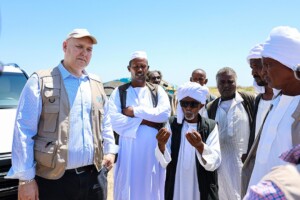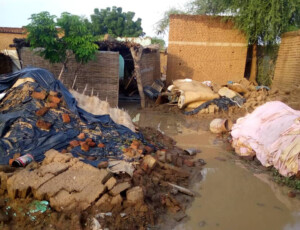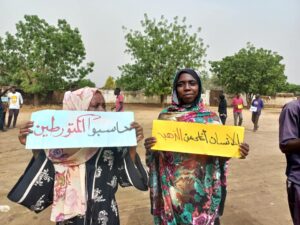50+ dead as swollen Blue Nile wreaks havoc in Sudan
Essential access routes to Ed Damazin, capital of Sudan’s Blue Nile state, have been cut-off as torrential rains and resultant flash floods continue to swell the flow of the Blue Nile. The official death toll in this season’s floods has risen to more than 50.
 Flood devastation in River Nile state (File photo: Hadreen)
Flood devastation in River Nile state (File photo: Hadreen)
Essential access routes to Ed Damazin, capital of Sudan’s Blue Nile state, have been cut-off as torrential rains and resultant flash floods continue to swell the flow of the Blue Nile. The official death toll in this season’s floods has risen to more than 50.
Witnesses told Radio Dabanga that the river flowing through Khor El Melewiya cut off the road linking Wad El Nil with Ed Damazin at dawn on Monday. Traffic has completely halted and run-off waters continue to swell the Blue Nile.
The Civil Defence Department announced that the death toll in the floods thus far has risen to more than 50 people. Police Colonel Fathelaleem Abdelrahman, Director of the Civil Defence Department in Sennar and Rapporteur of the Committee for Rainy Season Emergencies, said in a press statement that the national road between Sennar and Ed Damazin (which is situated near the Roseires dam) was cut off after the town of Abu Hajjar at Khor El Gaara in two locations. He explained that the Civil Defence is securing the areas and facilitating the transport of stranded member of the public.
The water level of the Blue Nile in Singa rose six centimetres above the level of Saturday, when it reached 16.58 metres on Sunday, as a result of heavy rain in large parts of Sennar state, in addition to torrential rains flowing through Khor El Melewiya and Khor El Gaara. Vehicles were brought to a stop the vicinity of Khor El Gaara, south of Abu Hajjar.

showing flood affected areas in Sudan
In its latest Floods Flash Update published today, the UN Office for the Coordination of Humanitarian Affairs (OCHA) confirms that heavy rains and flash flooding have so far been reported in 12 out of 18 states including El Gizera, Blue Nile, El Gedaref, Khartoum, North Kordofan, Northern State, River Nile, Sennar, South Darfur, South Kordofan, West Darfur, and White Nile.
Over 61,800 people were affected as of 22 August. A total of 3,840 homes were destroyed, 8,160 damaged and an unconfirmed number of public infrastructure and farmland have been affected. Further assessments will take place in Al Riyadh internally displaced persons (IDP) camp in West Darfur and in El Gedaref State to verify the needs and the number of people affected.
West Darfur
On 18 and 19 August, 3,425 people were affected by heavy rains and flash floods in Al Riyadh IDP camp in Aj Geneina locality, West Darfur State. According to community leaders and initial observations, an unconfirmed number of latrines were either destroyed or damaged. In-depth assessments are planned to confirm the number of people affected and priority needs.
Over 5,640 people have been affected by heavy rains and flooding in West Darfur since July 2021. Humanitarian partners have started the distribution of non-food items (NFIs) and provided other humanitarian assistance to the people affected.
Over 627,000 people live in El Geneina locality, of whom over 30 per cent need humanitarian assistance according to the 2021 Sudan Humanitarian Needs Overview (HNO)*. Over 258,000 people in the locality are currently facing crisis levels of food security, according to the latest Integrated Food Security Phase Classification (IPC) report covering the period between June and September 2021.
El Gedaref
Inter-agency assessments are ongoing in Gedaref to confirm the number of people reported affected by flooding on 11 August. Initial reports indicate that over 4,715 people were affected by heavy rains and flash floods in El Mafaza town, Abu Rakham and Tunaydbah areas in El Mafaza locality. According to local sources over 1,200 feddans of farmland have been affected by the flooding. An unconfirmed number of latrines have been damaged, including in health facilities.
About 115,000 people live in El Mafaza, of whom about 23 per cent need humanitarian assistance according to the 2021 Sudan Humanitarian Needs Overview (HNO). Over 30,000 people in El Mafaza are in crisis and above levels of food security according to the latest IPC report.
Funding and supplies
There are stockouts of relief supplies in water, sanitation and hygiene (WASH), shelter, education, child protection and gender-based violence. There are non-food item stocks for 130,000 people.
In support of the flood response, the Sudan Humanitarian Fund has allocated US$7.7 million to 14 NGOs in 15 states to finance swift humanitarian response when needed. In addition, some $7 million has been allocated to four UN agencies for the procurement of emergency stocks. Another $3.5 million is available for floods rapid response activities.









 and then
and then